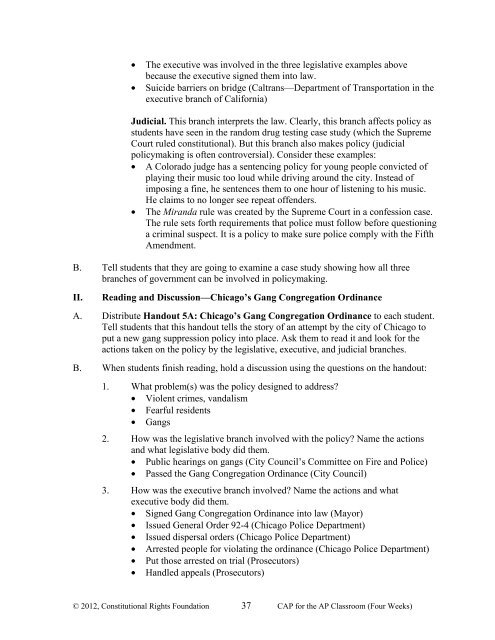Lesson 5: Policymaking in the Three Branches of Government
Lesson 5: Policymaking in the Three Branches of Government
Lesson 5: Policymaking in the Three Branches of Government
You also want an ePaper? Increase the reach of your titles
YUMPU automatically turns print PDFs into web optimized ePapers that Google loves.
• The executive was <strong>in</strong>volved <strong>in</strong> <strong>the</strong> three legislative examples above<br />
because <strong>the</strong> executive signed <strong>the</strong>m <strong>in</strong>to law.<br />
• Suicide barriers on bridge (Caltrans—Department <strong>of</strong> Transportation <strong>in</strong> <strong>the</strong><br />
executive branch <strong>of</strong> California)<br />
Judicial. This branch <strong>in</strong>terprets <strong>the</strong> law. Clearly, this branch affects policy as<br />
students have seen <strong>in</strong> <strong>the</strong> random drug test<strong>in</strong>g case study (which <strong>the</strong> Supreme<br />
Court ruled constitutional). But this branch also makes policy (judicial<br />
policymak<strong>in</strong>g is <strong>of</strong>ten controversial). Consider <strong>the</strong>se examples:<br />
• A Colorado judge has a sentenc<strong>in</strong>g policy for young people convicted <strong>of</strong><br />
play<strong>in</strong>g <strong>the</strong>ir music too loud while driv<strong>in</strong>g around <strong>the</strong> city. Instead <strong>of</strong><br />
impos<strong>in</strong>g a f<strong>in</strong>e, he sentences <strong>the</strong>m to one hour <strong>of</strong> listen<strong>in</strong>g to his music.<br />
He claims to no longer see repeat <strong>of</strong>fenders.<br />
• The Miranda rule was created by <strong>the</strong> Supreme Court <strong>in</strong> a confession case.<br />
The rule sets forth requirements that police must follow before question<strong>in</strong>g<br />
a crim<strong>in</strong>al suspect. It is a policy to make sure police comply with <strong>the</strong> Fifth<br />
Amendment.<br />
B. Tell students that <strong>the</strong>y are go<strong>in</strong>g to exam<strong>in</strong>e a case study show<strong>in</strong>g how all three<br />
branches <strong>of</strong> government can be <strong>in</strong>volved <strong>in</strong> policymak<strong>in</strong>g.<br />
II. Read<strong>in</strong>g and Discussion—Chicago’s Gang Congregation Ord<strong>in</strong>ance<br />
A. Distribute Handout 5A: Chicago’s Gang Congregation Ord<strong>in</strong>ance to each student.<br />
Tell students that this handout tells <strong>the</strong> story <strong>of</strong> an attempt by <strong>the</strong> city <strong>of</strong> Chicago to<br />
put a new gang suppression policy <strong>in</strong>to place. Ask <strong>the</strong>m to read it and look for <strong>the</strong><br />
actions taken on <strong>the</strong> policy by <strong>the</strong> legislative, executive, and judicial branches.<br />
B. When students f<strong>in</strong>ish read<strong>in</strong>g, hold a discussion us<strong>in</strong>g <strong>the</strong> questions on <strong>the</strong> handout:<br />
1. What problem(s) was <strong>the</strong> policy designed to address?<br />
• Violent crimes, vandalism<br />
• Fearful residents<br />
• Gangs<br />
2. How was <strong>the</strong> legislative branch <strong>in</strong>volved with <strong>the</strong> policy? Name <strong>the</strong> actions<br />
and what legislative body did <strong>the</strong>m.<br />
• Public hear<strong>in</strong>gs on gangs (City Council’s Committee on Fire and Police)<br />
• Passed <strong>the</strong> Gang Congregation Ord<strong>in</strong>ance (City Council)<br />
3. How was <strong>the</strong> executive branch <strong>in</strong>volved? Name <strong>the</strong> actions and what<br />
executive body did <strong>the</strong>m.<br />
• Signed Gang Congregation Ord<strong>in</strong>ance <strong>in</strong>to law (Mayor)<br />
• Issued General Order 92-4 (Chicago Police Department)<br />
• Issued dispersal orders (Chicago Police Department)<br />
• Arrested people for violat<strong>in</strong>g <strong>the</strong> ord<strong>in</strong>ance (Chicago Police Department)<br />
• Put those arrested on trial (Prosecutors)<br />
• Handled appeals (Prosecutors)<br />
© 2012, Constitutional Rights Foundation 37 CAP for <strong>the</strong> AP Classroom (Four Weeks)


